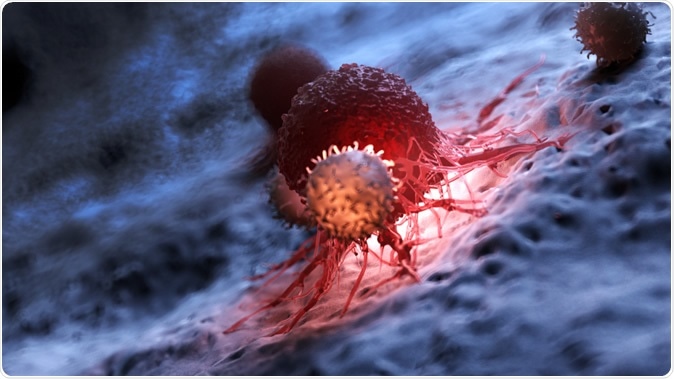A team of researchers from University of Texas at Arlington, University of Rhode Island and Brown University have collaborated to come up with use of nanoparticles in targeted therapy for deep seated cancers. Their success with the nanoparticles was published in a study titled, “X-ray induced photodynamic therapy with copper-cysteamine nanoparticles in mice tumors,” in the latest issue of the journal Proceedings of the National Academy of Sciences.

White blood cells attacking a cancer cell. Image Credit: Sebastian Kaulitzki / Shutterstock
The group of researchers came together to use copper-cysteamine (Cu-Cy) nanoparticles along with X rays to treat deep-seated tumors in lab mice. Their results revealed that penetrability of these nanoparticles into the tumour and reduction in the size of the tumour.
Senior author of the study Wei Chen, a UTA physics professor, has been working for a while in developing photosensitizer nanoparticles that would be used for therapy. These nanoparticles would be activated with X rays and at the site of their action they would act via activation of reactive oxygen species (ROS) that would kill the cancer cells and spare the healthy cells. ROS are lethal molecules for all cells and can cause serious damage to healthy cells when exposed. Chen explained, “Traditional nanoparticles used for photodynamic therapy can only be activated by light that is not highly penetrating, meaning we're limited with how deep we can go to target tumors.” He added, “Cu-Cy is unique among other nanoparticles we've investigated because it can be activated by radiation, which can penetrate far deeper and reach tumors throughout the body.” Thus their special nanoparticles were equipped to penetrate deep into the tumours.
Chen has also tried microwaves to activate the nanoparticles once they were inside the system. This is called photodynamic therapy he explained. He said, “We continue to pursue multiple combinations within photodynamic therapy. Each new discovery represents potential new avenues for treating cancer patients, because we can leave their healthy cells virtually unaffected.” The team wrote, “Copper-cysteamine nanoparticles can be activated directly by X-rays to produce singlet oxygen.”
Chen worked alongside Michael Antosh, assistant professor of physics and medical physics program director at the University of Rhode Island and eight other researchers on this project to realize the actual activity of these nanoparticles in a live system. Antosh said, “Building on Wei's expertise in this important research area, my lab focused on the experiments testing the effect of the nanoparticles on tumor size after radiation therapy.” He added, “With the help of expert analysis by Jing Wu, assistance professor of statistics at the University of Rhode Island, we have enough data to draw reliable conclusions for the first time that radiation and Cu-Cy nanoparticles act as an effective cancer treatment.”
The authors of the study wrote, “the results of this study demonstrate the potential of copper-cysteamine nanoparticles with deeply penetrating X-rays in the treatment of mammalian cancer to overcome current limitations of low penetration, light-induced photodynamic therapy treatment that can only treat superficial cancers.”
Chen said, “It is an honor to have our work highlighted in this important publication. This collaborative group has great synergy, and we are grateful that this is evidenced by the results of this study.” According to Alex Weiss, chair of UTA's physics department, “He (Chen) reaches across disciplines and to other institutions in order to fortify his research and maximize impact. We are grateful and proud to have Dr. Chen represent UTA in this important field of research on national and international scales.”
Authors of the study also wrote in conclusion, “This work confirms the effectiveness of copper-cysteamine nanoparticles as a photosensitizer when activated by radiation and suggests that these Cu-Cy nanoparticles may be good candidates for PDT (Photodynamic therapy) in deeply seated tumors when combined with X-rays and conjugated to a tumor-targeting molecule.”Antosh said, “The overall goal is to someday use these nanoparticles during radiation therapy in cancer patients. The next step is to investigate some clinically important variables in order to adapt the methods from this pilot study to what happens in treatments in clinical settings.”
Previous study by Wei Chan on use of nanoparticles and microwaves in PDT
Wei Chen and colleagues from Guangdong Academy of Medical Sciences and Beihang University, this year in June published another article in Nanomedicine: Nanotechnology, Biology and Medicine. In this article they used titanium dioxide (TiO2) nanoparticles stimulated by microwaves to become activated and kill the cancer cells. This targeted therapy spared the healthy cells around the cancer.
This therapy called the microwave-induced radical therapy was called microdynamic therapy, or MDT. This was the first such study to show the use of microwaves in activation of nanoparticles and release of ROS. Chen said, “Cancer cells are characterized by a higher steady-state saturation of ROS than normal, healthy cells. This new therapy allows us to exploit that by raising the saturation of ROS in cancer cells to a critical level that triggers cell death without pushing the normal cells to that same threshold.”
The team explained that activation of ROS and treating deep seated tumours was difficult using light and this hurdle was overcome by microwaves. Chen said, “This new discovery is exciting because it potentially creates new avenues for treating cancer patients without causing debilitating side effects. This targeted, localized method allows us to keep healthy cells intact so patients are better equipped to battle the disease.”
Source:
Journal reference:
X-ray induced photodynamic therapy with copper-cysteamine nanoparticles in mice tumors Samana Shrestha, Jing Wu, Bindeshwar Sah, Adam Vanasse, Leon N Cooper, Lun Ma, Gen Li, Huibin Zheng, Wei Chen, Michael P. Antosh Proceedings of the National Academy of Sciences Aug 2019, 116 (34) 16823-16828; DOI: 10.1073/pnas.1900502116, https://www.pnas.org/content/116/34/16823